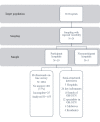Caesarean birth in public maternities in Argentina: a formative research study on the views of obstetricians, midwives and trainees
- PMID: 35078842
- PMCID: PMC8796244
- DOI: 10.1136/bmjopen-2021-053419
Caesarean birth in public maternities in Argentina: a formative research study on the views of obstetricians, midwives and trainees
Abstract
Objectives: To explore obstetricians', midwives' and trainees' perceptions of caesarean section (CS) determinants in the context of public obstetric care services provision in Argentina. Our hypothesis is that known determinants of CS use may differ in settings with limited access to essential obstetric services.
Setting: We conducted a formative research study in 19 public maternity hospitals in Argentina. An institutional survey assessed the availability of essential obstetric services. Subsequently, we conducted online surveys and semistructured interviews to assess the opinions of providers on known CS determinants.
Results: Obstetric services showed an adequate provision of emergency obstetric care but limited services to support women during birth. Midwives, with some exceptions, are not involved during labour. We received 680 surveys from obstetricians, residents and midwives (response rate of 63%) and interviewed 26 key informants. Six out of 10 providers (411, 61%) indicated that the use of CS is associated with the complexities of our caseload. Limited pain management access was deemed a potential contributing factor for CS in adolescents and first-time mothers. Providers have conflicting views on the adequacy of training to deal with complex or prolonged labour. Obstetricians with more than 10 years of clinical experience indicated that fear of litigation was also associated with CS. Overall, there is consensus on the need to implement interventions to reduce unnecessary CS.
Conclusions: Public maternity hospitals in Argentina have made significant improvements in the provision of emergency services. The environment of service provision does not seem to facilitate the physiological process of vaginal birth. Providers acknowledged some of these challenges.
Keywords: maternal medicine; organisation of health services; public health.
© Author(s) (or their employer(s)) 2022. Re-use permitted under CC BY. Published by BMJ.
Conflict of interest statement
Competing interests: None declared.
Figures
References
-
- Ministerio de Salud de la Nación Argentina . Dirección de Estadísticas e Información de la Salud [Internet].. Available: https://www.argentina.gob.ar/salud/deis [Accessed 20 Nov 2021].
Publication types
MeSH terms
Grants and funding
LinkOut - more resources
Full Text Sources
Medical

